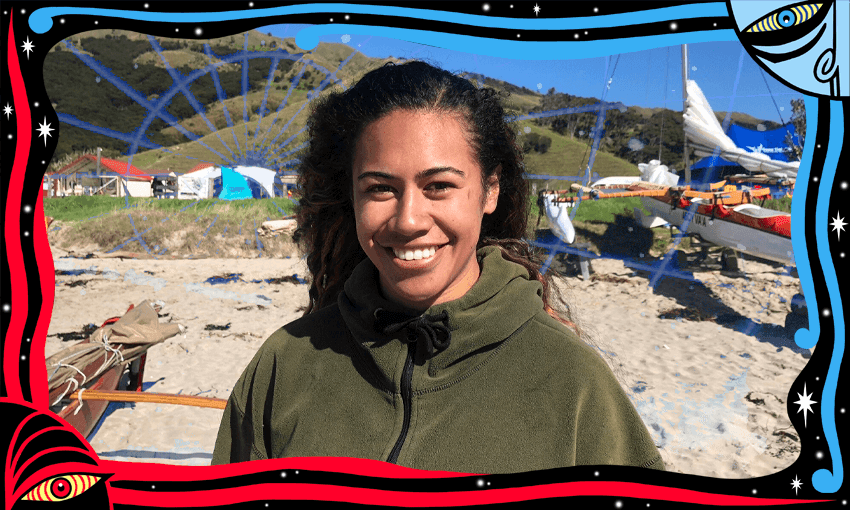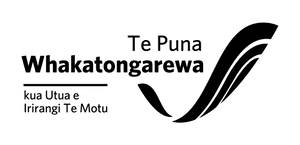Riding the waves of the waka hourua resurgence, Hinerapa Rupuha is learning the traditional methods of Māori navigation.
Hinerapa Rupuha of Ngāti Kahungunu Ki Tamatea and Te Whānau a Apanui is a trainee celestial navigator who uses the stars, the sun, the moon and the tides to identify direction and time.
She is no stranger to water pursuits, having grown up in the world of competitive waka ama.
“I grew up paddling and I was also brought up in total immersion, so we learnt a lot about voyaging. You know, you hear all the stories about the migration, stories about the stars and how they can lead you. All of that was fascinating to me,” says Rupuha.
Her education and participation in waka ama as a sport gave her a cultural grounding and confidence on the water that would later lend itself to a natural transition into other cultural practices of waka Māori.
“Once I started getting into waka tētē and waka tangata, I learned more about our waka hourua,” says Rupuha.
Celestial navigators like Hinerapa Rupuha are at the mercy of Tāwhirimātea, Tangaroa and Ranginui (Photos: Supplied)
A graduate of Te Kura Kaupapa Māori o Hoani Waititi, based at Hoani Waititi marae in west Auckland, everyday she would hear stories of migration, about how our ancestors came from Hawaiki and even how some had competitions over who arrived first and where they landed.
“I always thought, are these just kōrero that we talk about on the marae? Is it something to make your speech flash? That’s me as a young, critical, analytical Hinerapa. Do you just say that because it sounds cool, or do you actually believe in it? Then I had to look at myself and question, do I actually believe what they’re saying? So I challenged myself to go and find out,” says Rupuha.
Māori proverbial sayings about our stars, such as, “Ko Atutahi te whetū tapu i te rangi” and “Takurua pūhaehae”, are phrases she had heard or been taught, although she felt she still didn’t know their true meaning.
“I knew Matariki, I knew Puanga, but I couldn’t point them out. I knew Tautoru, I knew Atutahi, I knew Takurua but again, I couldn’t point them out,” says Rupuha.
Looking up at our night skies, she wondered what made those stars significant to Māori, harbouring a curiosity that eventually put her on the course that would change her life.
“Since going into waka, if I were to say these things, if I were to do a karanga or a pao and use those sayings or proverbs about the stars and migration, it won’t be because it was taught to me, it’s because I know,” says Rupuha.
Embarking on a waka hourua journey
A pivotal moment that influenced her decision to be a voyager was Te Mana o Te Moana, where seven new waka hourua were built in Aotearoa in 2010 and in the following year sailed on their maiden voyages across the Pacific to Hawai’i and the west coast of the United States. Each waka was represented by different island nations and the aim of the voyage was to train a new generation of kaumoana and celestial navigators.
Seeing the achievements of Te Mana o Te Moana and how those waka successfully circumnavigated the Pacific through traditional methods used by our ancestors, Rupuha was convinced, making the decision to get on board.
“I knew that it’s not just a story and it’s still alive today, so why not jump into it,” says Rupuha.
Rupuha started voyaging in 2015, joining the second intake of Te Kura o Ngā Kuri a Tarawhata, the celestial navigational school led by master navigator Jack Thatcher.
“I didn’t know who Jacko was at the time. I didn’t know Mau Piailug or Nainoa Thompson and I got the whole 101 there and never stopped,” says Rupuha.
Captain Thatcher was a student of Micronesian master navigator Mau Piailug of the Carolinian island of Satawal, who was the force behind revitalisation of traditional non-instrument navigation in Te Moana Nui a Kiwa.
Master navigator Nainoa Thompson, with the guidance of Mau Piailug, helped the culturally iconic Hawaiian waka Hōkūle’a embark on a pivotal and historic voyage, sailing from Hawai’i to Tahiti in 1976 for the first time in 500 years.
The late Sir Hekenukumai Busby, along with Jack Thatcher, Hoturoa Kerr, Stanley Conrad, Piripi Smith and many others, have been at the forefront of the waka revival in Aotearoa.
For Hinerapa Rupuha, it was a new world of learning and she embraced that legacy wholeheartedly, giving the last seven years of her life to continue those waka traditions.
“We would voyage three to four months, every year since we started, usually in the summer. Starting in September, we would go through to cyclone season around March-April. Our first voyage we would go up to Waitangi, then down the East Coast but we would stay on the waka for the entire time,” says Rupuha.
Throw in a couple voyages to Rēkohu, where the kaumoana stay for two weeks at a time, and Rupuha and her peers were gaining hands-on ancestor knowledge.
Sailing aboard Ngāhiraka, guided by Thatcher and Captain Mahara Nicholas, she has gained invaluable experiences, stories, life lessons and knowledge.
Te Korokoro o Te Parata, a great whirlpool that is retold in the migration narratives of Te Arawa, is a story she was familiar with growing up. However, Rupuha says it’s not until you physically get on the waka that you actually understand what Te Korokoro o Te Parata is.
“All you think about is ‘a waka went into a whirlpool, and what’ – you’re not really affected by it but when you can feel the wind touching you, the rain, the waves coming over you… you remember all of those things that they were saying and you know this is real, this is how I got here,” says Rupuha.
The art of navigation
Sailing aboard Ngāhiraka, she began learning about the stars, although the sun is always the first marker in the sky.
“The whole romanticised version of waka is usually the stars, but the sun is probably your best friend, because it’s easy to see and it’s always constant. Next are the stars, because they don’t move, they’re reliable. There’s the moon as well, for multiple reasons including direction and time but also weather patterns,” says Rupuha.
The more difficult signs to read are the wind, swell, the clouds and the planets.
Those are the elements that the kaumoana and trainee navigators are taught to observe throughout the four months they are with Thatcher.
“Your main goal in navigation is to identify time and direction. That is your only job but also the biggest job. That navigator looks after the waka, the captain looks after the people,” says Rupuha.
Those who have been sailing will know it’s not always smooth and you are at the mercy of Tāwhirimātea, Tangaroa and Ranginui.
“The navigator can tell the captain which way they’re supposed to go but if the waka is saying no, if the wind is not letting you, then the navigator needs to know how far we’re off our course,” says Rupuha.
The role of the navigator is to sit and observe, to feel the elements and keep an ongoing understanding of where the waka is at all times in relation to the island from which it has departed and its next destination.
For Rupuha, it’s about entering a different state of mind where you’re in another world.
“It’s like before I go into the karanga, I’m not Hinerapa. I’m the medium for my iwi. It’s not about my pride or how good I sound, it’s about what is good for everyone else.
“You have to be in tune with the elements and the atua. You have to listen to Tāne, to Tangaroa, to the sound of the waves hitting the waka and feel the direction of the wind on your cheek. You have to feel them as if you are those things,” says Rupuha.
The plan for the second intake of trainee navigators was to train for five years and in the fifth year do a voyage, although in 2020 the world changed with the arrival of Covid-19.
“There are plans to go to Tonga but it all depends on Covid now, so we’re standing by and when the chief says go, then we go,” says Rupuha.
Reflecting on her experiences and the narratives of our ancestors, Rupuha says she can’t wait to tell her mokopuna about the adventures of people like Jack Thatcher, Hoturoa Kerr and Sir Hekenukumai Busby.
She will have her own stories to tell as well, about how she navigated the deep waters and made multiple trips between islands in the traditional ways of her ancestors.
For Rupuha, the narratives of how Māori circumnavigated the greatest expanse of ocean in the world through traditional methods of understanding and being one with the elements are no longer just stories – they are her lived experience, her reality.
“When I come off the waka, I know where the stars are and how they’re moving even if the sun is up. I want us as Māori to be able to get to a place where that’s normal,” says Rupuha.
As we become more enlightened around Matariki, Rupuha hopes it motivates our people to not only look up at our skies but to gain a deeper understand standing of how we can enrich our lives through learning about the stars, the sun, the moon and the tides, to identify time and direction in a Māori way as we navigate into the future.

